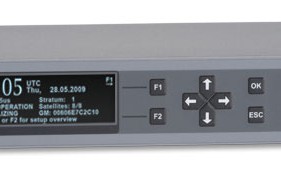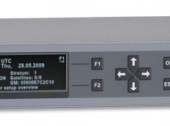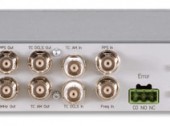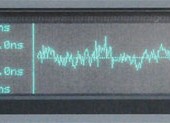Servidores de Tiempo LANTIME M600 PTP v2




Características del producto
Meinberg LANTIME time servers are used around the world to provide accurate time to networks of any size. The LANTIME M600/MRS/PTP synchronizes all systems that are PTPv2, NTP- or SNTP-compatible. It uses a built-in Meinberg GPS receiver and supports a broad range of other reference time sources like 1PPS, 10MHz, IRIG time codes (both DCLS and AM) or upstream NTP servers. The built-in PTP unit can be configured to act either in master or slave mode. Therefore it is possible to use PTP as an additional input reference for the MRS engine. The appliance is a perfect solution to measure and compare the different reference time sources against each other. A highly stable and precise oscillator is capable of bridging interferences or a temporary loss of reception and can also be used as a stable independent time base when operated in free running mode.
Being a very stable IEEE 1588-2008 Grandmaster clock, the LANTIME M600/MRS/PTP not only provides a highly accurate source of synchronization for PTP clients (“”slaves”” like the PTP270PEX), it additionally introduces the absolute time (“”current time of day””) to your PTP networks.
The PTP V2 (Multicast/Unicast) implementation is fully compliant to the IEEE 1588-2008 standard and provides PTP management messages as well. In master mode, the PTP unit is able to synchronize two-step clocks, whereas in Slave mode, it can be synchronized by either a one-step clock or a two-step clock.
As an ultra stable NTP and PTP time provider, the LANTIME M600/MRS/PTP not only represents a highly accurate source of synchronization for all network devices supporting the Precision Time Protocol (PTP), the Network Time Protocol (NTP) and the Simple Network Time Protocol (SNTP), it also offers a number of legacy time and frequency outputs for keeping non-networked devices in sync.
The Meinberg MRS technology (Multi Reference Sources) enables you to utilize one or more time and frequency references in prioritized order defined by your individual requirements. The Meinberg Intelligent Reference Switching Algorithm (IRSA) ensures that switching from a highly accurate reference source (e.g. GPS) to a less accurate one (e.g. IRIG or NTP) is delayed as long as the internal ultra stable oscillator is capable of maintaining an accuracy level that is better than the one of the next available reference source in the priority list.
Redundancy of input references
The MRS technology offers a flexible solution to the changing availability of different synchronization sources for highly critical operating systems. The ability to use multiple independent sync references allows you to fulfill redundancy requirements of your network synchronization solution.
Lab environments
Monitoring and measurement of synchronization sources such as determining and logging the accuracy of an IRIG generator or a PPS source is easily done with the MRS. Furthermore, the LANTIME M600/MRS/PTP is a perfect solution to test the PTP synchronization quality within existing network environments by automatically comparing the PTP input source to another high accurate reference source like GPS or 1PPS. All reference inputs can be measured against each other, and the high quality VF-Display provides a graphical representation of the measurements between different reference sources.
PTPv2 Translator
The MRS system allows you to translate PTP into a variety of output signals like 1PPS, 10MHz or IRIG. This feature makes it easy to transfer legacy timing signals over a IP based infrastructure while maintaining very high accuracy.
The GNU/Linux operating system of the LANTIMEs SBC (Single Board Computer) has been optimized to ensure a high level of security and reliability.
The configuration of the system can be done by using a standard web browser to access the extensive but straightforward HTML interface. Alternatively a text based and menu driven setup utility can be started from the shell prompt after logging into the unit via Telnet or SSH.
The security-related features of LANTIME time servers satisfy highest demands. The time synchronization data can be reliably signed and secured by symmetric keys (MD5) and the NTP autokey procedures. This protects the clients against manipulated time and man-in-the-middle attacks and allows them to verify that the NTP packets they received were send by the LANTIME. Additionally the whole LANTIME configuration can be done by using encrypted channels (e.g. SSH, HTTPS or SNMPv3). Every unused/unneeded protocol can be disabled in order to reduce possible points of attack.
In order to support network management systems the LANTIME time servers offer an extensive SNMP interface, which can be accessed by SNMP V1, V2.c and V3. It allows the monitoring of all relevant system parameters (including operating system parameters, network interface statistics, detailed GPS and NTP status information as well as the complete system configuration) and can be used to alter the LANTIME configuration via SNMP set commands, too.
LANTIME time servers are designed to be deployed in IPv6 networks, the NTP time synchronization as well as the configuration interfaces (Web-based, SSH and SNMP) comes with IPv6 support. You can assign several IPv6 addresses and the system supports automatic configuration by IPv6 autoconf.
Because of its modular system architecture it is possible to equip a LANTIME time server with a variety of different reference time sources. Optionally several additional frequency-, serial string- and pulse outputs are available and by combining two (even different) time sources and redundant power supplies, high-availability systems are no problem.
The LANTIME M600/MRS/PTP is equipped with high precision oscillator “”OCXO HQ”” (look at oscillator options for details) as standard. The oscillator determines the holdover characteristics (e.g. when the GPS signal is disturbed or jammed). The oscillator option “”OCXO DHQ”” is available to fulfill higher requirements.
Please note that the GPS antenna is not included in the standard scope of delivery and has to be ordered separately, if you are planning to use GPS as a synchronization source.
Especificaciones técnicas
| Type of receiver | 6 channel GPS C/A-code receiver |
| Display | Vacuum fluorescent graphic display (VFD), 256 x 64 dots |
| Control elements | Eight push buttons to set up basic network parameters and to change receiver settings |
| Status info | Four bicolor LEDs showing status of: |
| – reference time | |
| – time service | |
| – network | |
| – alarm | |
| Input signal | 1x GPS Antenna Input |
| 1x PPS in | |
| 1x 10MHz in | |
| 1x IRIG DCLS in | |
| 1x IRIG AM in | |
| 1x PTPv2 in (if configured as PTP slave) | |
| Pulse Synchronization Input Signals | 1 Pulse Per Second, TTL (BNC) |
| Frequency inputs | 10 MHz sine (1,5Vpp) or |
| 10 MHz TTL | |
| IRIG Time Code Input | IRIG-B123, B122, B003, B002, B006, B007, B126, B127, IEEE 1344 and AFNOR NFS 87-500 |
| Frequency outputs | 10 MHz via female BNC connector, TTL into 50 Ohm |
| Synthesizer 1/8 Hz up to 10 MHz via female BNC connector, TTL into 50 Ohm | |
| Accuracy depends on oscillator (standard: OCXO HQ), look at oscillator options | |
| Pulse outputs | Pulse per second (PPS) and pulse per minute (PPM) via female BNC connectors, TTL into 50 Ohm, pulse width: 200msec, active high |
| Accuracy of pulse outputs | < ±100ns (OCXO HQ, OCXO DHQ) |
| Interface | Two independent serial RS232-interfaces, menu configurable |
| Data format of interfaces | Baud rates: 300, 600, 1200, 2400, 4800, 9600, 19200 Baud |
| Data formats: 7N2, 7E1, 7E2, 7O1, 8E1, 8N1, 8O1 | |
| Time strings: Meinberg Standard-Telegram , SAT, Uni Erlangen (NTP), SPA, RACAL, Sysplex, NMEA0183 (RMC, GGA, ZDA), Meinberg GPS, COMPUTIME, ION oder Capture-Telegramm | |
| Unmodulated time code output | DCLS, TTL into 50 Ohm via female BNC connector, active high |
| Modulated time code output | IRIG AM sine wave signal via female BNC connector: |
| 3Vpp (MARK), 1Vpp (SPACE) into 50 Ohm | |
| Generated time codes | IRIG B002: 100pps, DCLS signal, no carrier, BCD time of year |
| IRIG B122: 100pps, AM sine wave signal, 1 kHz carrier, BCD time of year | |
| IRIG B003: 100pps, DCLS signal, no carrier, BCD time of year, SBS time of day | |
| IRIG B123: 100pps, AM sine wave signal, 1kHz carrier, BCD time of year, SBS time of day | |
| IEEE1344: Code according to IEEE1344-1995, 100pps, AM sine wave signal, 1kHz carrier, BCD time of year, SBS time of day, IEEE1344 expansion for date, time zone, daylight saving and leap second in Control Funktions Segment | |
| AFNOR: Code according to NFS-87500, 100pps, AM sine wave signal, 1kHz carrier, BCD time of year, complete date, SBS time of day | |
| Alarm output | Synchronous state of the module, relay output (changeover contact) |
| Network Interface | 1 x 10/100 MBit with RJ45, IEEE 1588 |
| 5 x 10/100 MBit with RJ45 | |
| Power supply | Standard: 100-240 VAC |
| available DC variants: 100-240 VDC, 12VDC, 24VDC and 48VDC | |
| Power consumption | 30W |
| Universal Serial Bus (USB) Ports | 1x USB Port in front panel: |
| – install firmware upgrades | |
| – backup and restore configuration files | |
| – copy security keys | |
| – lock/unlock front keys | |
| Supported Time String Formats | Meinberg Standard Timestring, Uni Erlangen Timestring, SYSPLEX Timer, NMEA, Computime, ABB-SPA, SAT, Arbiter |
| Single-Board-Computer | i386 compatible 500Mhz CPU, 128 MB RAM |
| Operating System of the SBC | Linux with nano kernel (incl. PPSkit) |
| Network protocols OSI Layer 4 (transport layer) | TCP, UDP |
| Network protocols OSI Layer 7 (application layer) | TELNET, FTP, SSH (incl. SFTP, SCP), HTTP, HTTPS, SYSLOG, SNMP |
| Internet Protocol (IP) | IP v4, IP v6 |
| Network Autoconfiguration Support | IPv4: Dynamic Host Configuration Protocol – DHCP (RFC 2131) |
| IPv6: Autoconfiguration Networking – AUTOCONF | |
| Network Time Protocol (NTP) | NTP v2 (RFC 1119), NTP v3 (RFC 1305), NTP v4 (no RFC) |
| SNTP v3 (RFC 1769), SNTP v4 (RFC 2030) | |
| MD5 Authentication and Autokey Key Management | |
| Precision Time Protocol (IEEE 1588) | PTP/ IEEE 1588-2008 including |
| Network Protocols: | |
| – UDP/IPv4 (Layer 3) (Multicast/Unicast) | |
| – IEEE 802.3 (Layer 2) (Multicast) | |
| Delay Mechanisms: | |
| – End-to-End (Multicast/Unicast) | |
| – Peer-to-Peer (Multicast) | |
| PTP Management Messages for monitoring and configuration | |
| Time Protocol (TIME) | Time Protocol (RFC 868) |
| Daytime Protocol (DAYTIME) | Daytime Protocol (RFC 867) |
| IEC 61850 | Synchronization of IEC 61850 compliant devices by using SNTP |
| Hypertext Transfer Protocol (HTTP) | HTTP/HTTPS (RC 2616) |
| Secure Shell (SSH) | SSH v1.3, SSH v1.5, SSH v2 (OpenSSH) |
| Telnet | Telnet (RFC 854-RFC 861) |
| Simple Network Management Protocol (SNMP) | SNMPv1 (RFC 1157), SNMPv2c (RFC 1901-1908), SNMP v3 (RFC 3411-3418) |
| Form Factor | 19 inch multipac metal case 1U/84HE – see Physical Dimension LANTIME Time Servers. |
| Ambient temperature | 0 … 50°C / 32 … 122°F |
| Humidity | Max. 85% |
| Scope of supply | Time Server, power cable and a USB storage device with Quick-Start Guide and a detailed reference manual as PDF file in the “Manual” folder. |
| Technical Support | Meinberg offers free lifetime technical support via telephone or e-mail. |
| Warranty | Three-Year Warranty |
| Firmware Updates | Firmware is field-upgradeable, updates can be installed directly at the unit or via a remote network connection. |
| Software updates are provided free of charge, for the lifetime of your Meinberg product. | |
| RoHS-Status of the product | This product is fully RoHS compliant |
| WEEE status of the product | This product is handled as a B2B category product. In order to secure a WEEE compliant waste disposal it has to be returned to the manufacturer. Any transportation expenses for returning this product (at its end of life) have to be incurred by the end user, whereas Meinberg will bear the costs for the waste disposal itself. |
